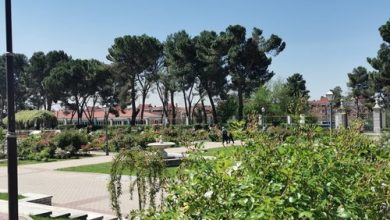How to take care of the garden soil. Fertilizers and work to improve the land
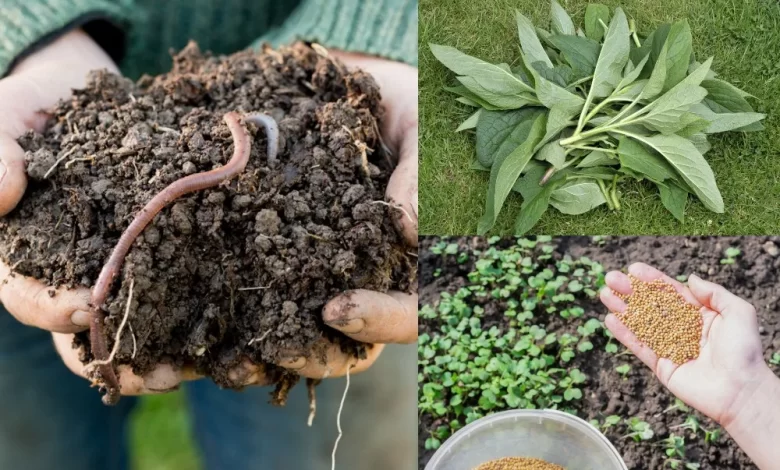
The fertility of the land is essential for the proper development of crops. Having rich, fertile soil is the foundation of a good vegetable garden. Our plants have an aerial part and an underground part. In both environments, both in the area that we see and on the ground, we must provide them with the best possible conditions.
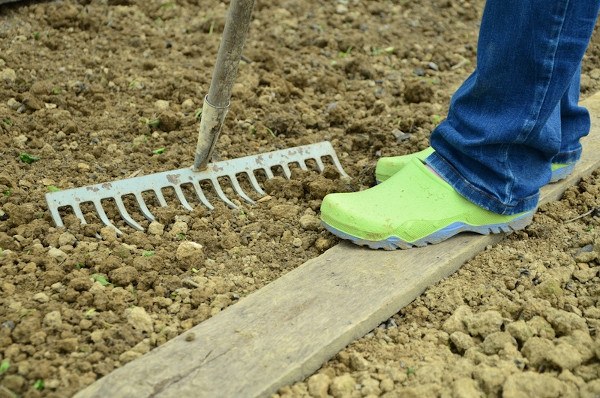
In today’s post we will talk about how to care for and improve the soil of the garden so that the roots obtain from it all the nutritional substances that the plants need.
To take care of the soil, it is important to know well what this «living sustenance» of plants is like and how it works, so first we will see what some of the components of the soil are: humus, microbiota and macrobiota.
The importance of soil organic matter: humus
Garden plants need a good amount of nutrients to grow and develop properly. Nutrients are obtained from the soil through the roots, and come from the mixture of naturally decomposed organic material (humus) and the manures or fertilizers that we add to improve the soil.
What is humus?
Humus is a dark – colored fertilizing substance present in the upper layers of the soil. It is made up of nitrogen, carbon and other essential nutrients for plants, which come from the degradation of more complex substances and which, due to their degree of decomposition, can be easily absorbed by the roots.
Humus comes from different organic remains (remains of leaves and branches, plant exudates, corpses and excrement of insects and other animals…) that have been degraded over the years by the microbiota and macrobiota that inhabit the soil.

There are several types of humus depending on the climate and the vegetation of the place where it is formed (forest mulch, peat…), but in all cases the material has a large quantity of very beneficial and easily assimilated nutritional substances by plants.
The use of pesticides and chemical fertilizers can degrade or remove humus from the soil; and repeated and deep tillage reduces its availability for plants, since it buries it and interrupts its formation.
To favor the conservation and renewal of humus in the soil, ecological techniques are recommended, such as those that we will see later.
soil microorganisms
Microorganisms are essential for the fertility of the soil in our orchard.
What is the microbiota?
Bacteria, fungi and other microscopic organisms make up the soil microbiota and play a very important role in having a fertile soil. These organisms are responsible for the soil being a living element in transformation.
Although it is true that some microorganisms cause diseases in crops, most of the soil microbiota is very beneficial for plant growth (in a single gram of healthy soil we find millions of beneficial microorganisms).
Many fungi and bacteria in the soil are a defense against pathogenic fungal infections, while others eliminate toxic compounds or collaborate in the decomposition of organic matter and its transformation into nutrients that are easily assimilated by plants.
The importance of the macrobiota
We have already mentioned that the microbiota or soil microorganisms are very important, but so is the macrobiota.
What is the macrobiota?
The macrobiota are the largest organisms such as earthworms, insects and other macroscopic living beings that are present in the soil and also have an important mission. These organisms, in addition to providing organic matter thanks to their droppings and exudates, loosen the soil and promote aeration and water retention.

Vermiculture or vermiculture is a technique based on the breeding of earthworms to obtain vermicompost or earthworm humus, a humified and very complete natural fertilizer from the excrement of these annelids.
How can we improve the garden soil? ecological techniques
There are several ways to care for the soil before and during the development of garden crops. One of them is tillage or soil management (with techniques such as weeding or the use of padding), and another is the incorporation of different types of fertilizers.
Conservation tillage for orchards (pamper the soil)
To take care of the soil we can carry out several tasks that improve its structure and its capacity to retain water and nutrients. Some of these tasks to take care of the soil are:
- Soil tillage of orchard soil
- Mulching or padding
- Conservation tillage
- weeding
soil tillage
It is important to carry out this work if hard layers have formed in the soil or the land has not been cultivated for a long time, to eliminate the «crust» that may have formed.
The cultivation or plowing of the soil causes the superficial layers to be aerated, which favors the roots of the crops that we will plant later to advance and develop correctly.

This tillage (with a mechanical mule or motorized tractor, hoe, mattock, shovel or other farming tools) can also be used to eliminate weeds and remains of previous crops.
For the conservation of humus and soil structure, it is not recommended to do deep tillage every year on the same place. In organic farming, minimum tillage is practiced: surface tillage, on stubble or pre-existing vegetation, no tillage…
Mulching or padding to protect the soil
The mulching or padding technique consists of putting on the surface of the soil, around the plants, a layer that can be made of various materials (organic or inorganic) that prevents light from passing into the soil and protects it from sudden changes in temperature. and of erosion.
In addition to preventing weeds from emerging (due to lack of light and space), mulch reduces erosion or soil degradation and improves moisture conditions in the root zone. There are many types of mulches or mulches to improve the soil. Some are inert, such as plastic sheets or gravel, and others, organic mulches, serve, in addition to being a physical barrier, to fertilize the soil.
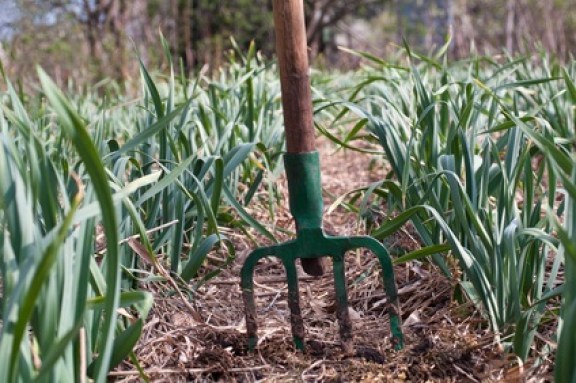
In organic mulches, the organic matter breaks down little by little in the soil and transforms into humus for plant nutrition. In the post Types of organic mulches you have more information about the types of mulching and the advantages of each one.
Conservation tillage
This ecological technique consists of protecting the soil using the remains of the previous crop. With conservation tillage, tillage of the soil is eliminated or greatly reduced (for example, tillage can be done in ridges or strips -not on the entire surface-, or tillage on stubble, which is not eliminated previously).
Like mulching, conservation tillage improves humidity and slows down soil degradation, something very important, especially in arid areas with rainfed crops.

The main condition is that the sowing or planting is carried out with at least 30% of the residues of the previous crop present in the land.
Crop residues can be cut and chopped and buried in the soil as green manure or hot bed, or, conversely, cut and left on the surface as mulch.
How to avoid compaction
It is very important that the soil or garden soil does not compact. The compaction of the land harms the development of crops.
If the soil is too compacted, the roots of the plants do not have enough air to develop.
It is important not to tread too much on the ground, because if we step too much on the ground, little by little it becomes compacted.
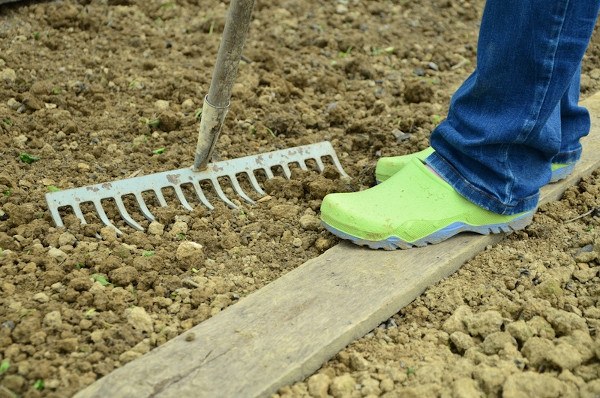
Using wooden or ceramic boards or walkways to walk through the orchard is a recommended practice. It favors that the weight of the people is distributed and not everything is concentrated on the same point.
orchard aeration
In addition to not treading excessively, or going through the orchard with machines or heavy vehicles, you can also do a job of aerating.
For this, there are manual tools or scarifying implements that can be attached to motorized tillers or mechanical mules.

weeding
It consists of pulling out, with the help of a light tool with sharp blades, the roots of the herbs that have emerged between the plants of the garden. The surface layer of the soil is removed and aerated or mulched to facilitate drainage and prevent the appearance of crusts.
It can be done with a small hoe or hoe, with a scarifier or scraper for weeds or with a double-handled pitchfork like the one in the image. If it is a small garden, in pots or on cultivation tables, it can be weeded with hand tools such as the cultivator or the almocafre.
Weeding or weeding is not always necessary, but it is important in some horticultural crops, especially if we have not put any padding to protect the soil.
Organic fertilizers to improve the soil
Organic fertilizers are made up of a complex mixture of inert mineral particles and organic matter. The macrobiota and microbiota of the soil gradually break down the organic matter and extract the nutrients it contains so that the plant can absorb them (mineralization of organic matter).
Organic fertilizers therefore come from decomposed organic matter or “living matter”. The humus naturally present in the soil is usually not enough to nourish the plants, so we must incorporate fertilizers or organic amendments to improve the soil.
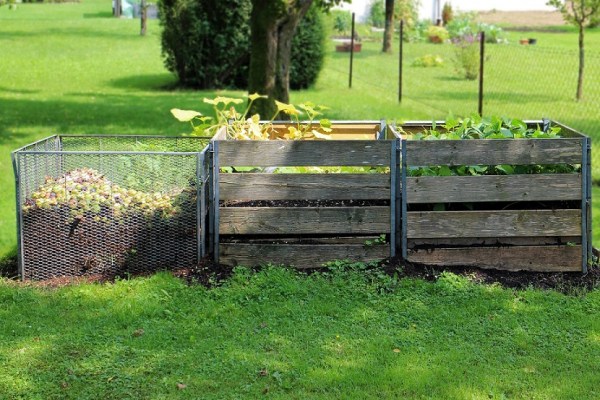
One of the most complete organic fertilizers to improve the garden soil is compost. It is easy to make homemade compost and it is an ideal fertilizer for vegetables and vegetables.
Other organic fertilizers are vermicompost or earthworm humus, manure, peat or green manures. In the post Types of organic fertilizer: 10 ecological fertilizers for plants we talk about how they are applied and the advantages of each of them.
mineral fertilizers
The main difference between organic fertilizers and mineral fertilizers is that the latter are inert. They are mainly composed of the fertilizing elements in their elemental form (calcium, phosphorus, magnesium…) in a form that is easily assimilated by the plant.
Unlike organic fertilizers, which take time to mineralize in the soil and make nutrients available to plants, mineral fertilizers provide directly assimilable nutrients. Due to this, they are absorbed by the plant much more quickly, and, in specific moments with serious nutrient deficiencies, they can solve the problem of preventing crops from spoiling.
There are two types of mineral fertilizers: chemical and natural. In organic farming, mineral fertilizers must always be natural. Chemical products that have been synthesized in laboratories, such as traditional nitrogenous fertilizers and other chemical fertilizers, cannot be used.
To replace traditional fertilizers, organic farming uses organic fertilizers and, occasionally, natural mineral fertilizers.
These are some of the natural materials to improve the soil through mineral fertilization and that are allowed in organic farming (according to the most important nutrient they provide):
- Magnesium and Sulfur: natural mineral amendments from dolomite, magnesite, epsonite (with magnesium) or sulfur.
- Potassium: wood ash, potassium salts such as sulphates or potassium chloride (sylvinite, carnallite, kainite…).
- Phosphorus: Thomas slag, calcined natural phosphates (such as aluminum calcium phosphate, which also provides aluminum and calcium)…
- Silicon: crushed siliceous rocks.
References
- FAO, 2000. Improving nutrition through family gardens and farms. Training Manual. Technological Primer 5: Soil improvement.
- Brechelt, A., 2004. Ecological soil management. Agriculture and Environment Foundation (FAMA), Dominican Republic.
- Félix Herrán, J. et al., 2008. Importance of organic fertilizers. Journal of Society, Culture and Sustainable Development of the Autonomous Indigenous University of Mexico, Ra Ximhai, vol. 4 (1), p. 57-67.
- López Garrido, R., 2010. Conservation tillage: short- and long-term effects on soil quality and crop development. Doctoral Thesis. University of Seville (Spain).


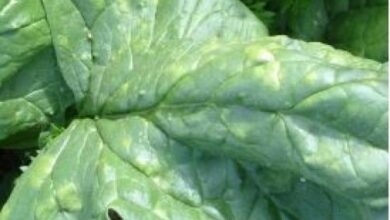
![Photo of Cut Trees: [Methods and Guide to Cut Down a Tree]](https://www.complete-gardening.com/wp-content/uploads/2022/08/cut-trees-methods-and-guide-to-cut-down-a-tree-390x220.jpg)
